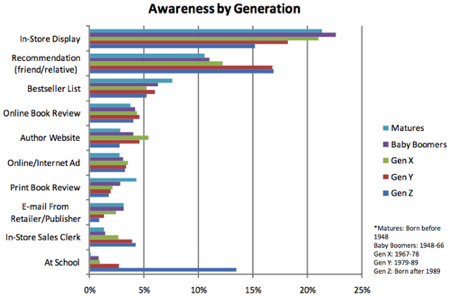
This chart sums up as well any the kind of shift that the “engagement editor” in your newsroom is trying to address. It’s from the April issue of the book-industry newsletter Publishing Trends (copy posted here) and it’s survey data asking book buyers how they became aware of the books they’ve purchased. Each bar represents a different age group, moving down from oldest (61-plus) to youngest (under 20).
For the oldest cohort, new books get discovered twice as often from an in-store display than through a recommendation from a friend. But for the youngest group (age 21 and under), a friend’s recommendation is a more common the path to a sale than those nice tables up front at Barnes & Noble. And the same trend line applies to the generations in between, too: The younger you are, the more likely it is that you learn about books through your social networks — online or in person — rather than through traditional promotion channels. (Note that print book reviews, bestseller lists, and direct email marketing from publishers and retailers also get less effective the younger the target audience — while a recommendation from an in-store sales clerk gets more effective.)
This shift is obviously a challenge for book publishers in particular and marketers in general, but it’s also a challenge for the news industry. Getting your content into the personal streams of your audience — where they can and hopefully will want to share it with their friends — is to 2010 what those “Make this site your home page” pleas were to 2002. And it’s more evidence that speaking with an institutional voice rather than a human one is not going to be effective with younger audiences.